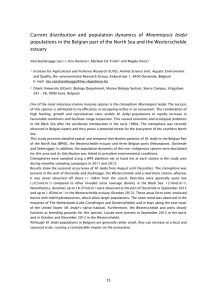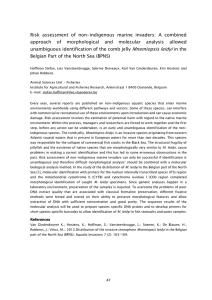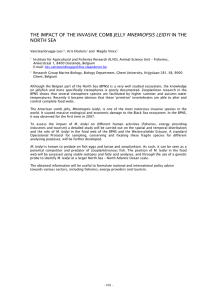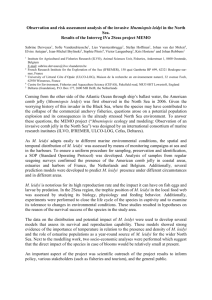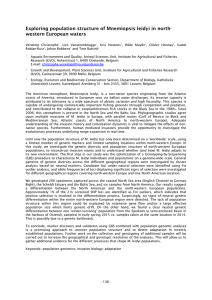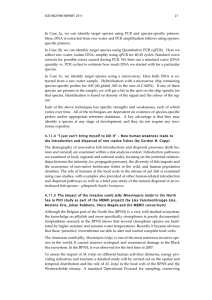Does latitude matter? A comparison of three non-indigenous species
advertisement
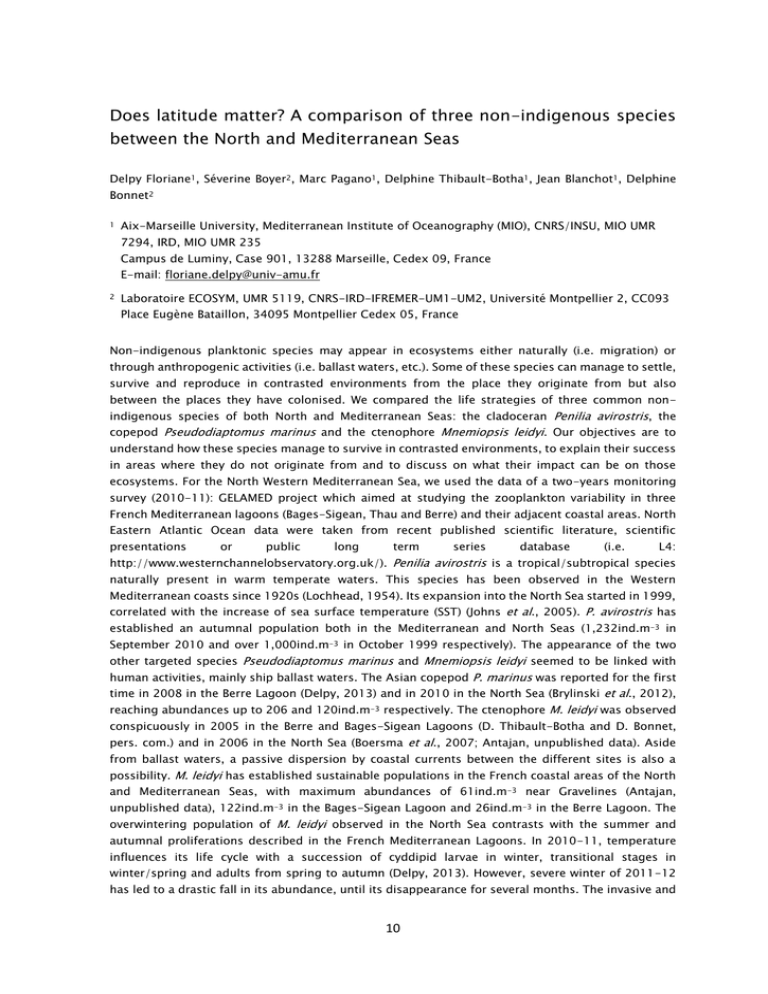
Does latitude matter? A comparison of three non-indigenous species between the North and Mediterranean Seas Delpy Floriane1, Séverine Boyer2, Marc Pagano1, Delphine Thibault-Botha1, Jean Blanchot1, Delphine Bonnet2 1 Aix-Marseille University, Mediterranean Institute of Oceanography (MIO), CNRS/INSU, MIO UMR 7294, IRD, MIO UMR 235 Campus de Luminy, Case 901, 13288 Marseille, Cedex 09, France E-mail: floriane.delpy@univ-amu.fr 2 Laboratoire ECOSYM, UMR 5119, CNRS-IRD-IFREMER-UM1-UM2, Université Montpellier 2, CC093 Place Eugène Bataillon, 34095 Montpellier Cedex 05, France Non-indigenous planktonic species may appear in ecosystems either naturally (i.e. migration) or through anthropogenic activities (i.e. ballast waters, etc.). Some of these species can manage to settle, survive and reproduce in contrasted environments from the place they originate from but also between the places they have colonised. We compared the life strategies of three common nonindigenous species of both North and Mediterranean Seas: the cladoceran Penilia avirostris, the copepod Pseudodiaptomus marinus and the ctenophore Mnemiopsis leidyi. Our objectives are to understand how these species manage to survive in contrasted environments, to explain their success in areas where they do not originate from and to discuss on what their impact can be on those ecosystems. For the North Western Mediterranean Sea, we used the data of a two-years monitoring survey (2010-11): GELAMED project which aimed at studying the zooplankton variability in three French Mediterranean lagoons (Bages-Sigean, Thau and Berre) and their adjacent coastal areas. North Eastern Atlantic Ocean data were taken from recent published scientific literature, scientific presentations or public long term series database (i.e. L4: http://www.westernchannelobservatory.org.uk/). Penilia avirostris is a tropical/subtropical species naturally present in warm temperate waters. This species has been observed in the Western Mediterranean coasts since 1920s (Lochhead, 1954). Its expansion into the North Sea started in 1999, correlated with the increase of sea surface temperature (SST) (Johns et al., 2005). P. avirostris has established an autumnal population both in the Mediterranean and North Seas (1,232ind.m-3 in September 2010 and over 1,000ind.m-3 in October 1999 respectively). The appearance of the two other targeted species Pseudodiaptomus marinus and Mnemiopsis leidyi seemed to be linked with human activities, mainly ship ballast waters. The Asian copepod P. marinus was reported for the first time in 2008 in the Berre Lagoon (Delpy, 2013) and in 2010 in the North Sea (Brylinski et al., 2012), reaching abundances up to 206 and 120ind.m-3 respectively. The ctenophore M. leidyi was observed conspicuously in 2005 in the Berre and Bages-Sigean Lagoons (D. Thibault-Botha and D. Bonnet, pers. com.) and in 2006 in the North Sea (Boersma et al., 2007; Antajan, unpublished data). Aside from ballast waters, a passive dispersion by coastal currents between the different sites is also a possibility. M. leidyi has established sustainable populations in the French coastal areas of the North and Mediterranean Seas, with maximum abundances of 61ind.m-3 near Gravelines (Antajan, unpublished data), 122ind.m-3 in the Bages-Sigean Lagoon and 26ind.m-3 in the Berre Lagoon. The overwintering population of M. leidyi observed in the North Sea contrasts with the summer and autumnal proliferations described in the French Mediterranean Lagoons. In 2010-11, temperature influences its life cycle with a succession of cyddipid larvae in winter, transitional stages in winter/spring and adults from spring to autumn (Delpy, 2013). However, severe winter of 2011-12 has led to a drastic fall in its abundance, until its disappearance for several months. The invasive and 10 dispersion success of this species seems to be strongly influenced by intensity and duration of the winter period. References Boersma M., Malzahn A.M., Greve W., Javidpour J. 2007. The first occurrence of the ctenophore Mnemiopsis leidyi in the North Sea. Helgoland Marine Research 61: 153-155. Brylinski J.-M., Antajan E., Raud T., Vincent D. 2012. First records of the Asian copepod Pseudodiaptomus marinus Sato, 1913 (Copepoda: Calanoida: Pseudodiaptomidae) in the southern bight of the North Sea along the coast of France. Aquatic Invasions 7 (4): 577-584. Delpy F. 2013. Ecologie du cténophore Mnemiopsis leidyi (Agassiz, 1865) dans l’Etang de Berre : Etude des facteurs contrôlant sa population et de son impact potentiel sur l’écosystème planctonique. Ph.D. Thesis, Aix-Marseille Université, Marseille, pp. 280. Johns D.G., Edwards M., Greve W., SJohn A.W.G. 2005. Increasing prevalence of the marine cladoceran Penilia avirostris (Dana, 1852) in the North Sea. Helgoland Marine Research 59: 214-218. Lochhead J.H. 1954. On the distribution of a marine cladoceran, Penilia avirostris Dana (Crustacea, Branchiopoda), with a note on its reported bioluminescence. Biological Bulletin 107: 92-105. 11
